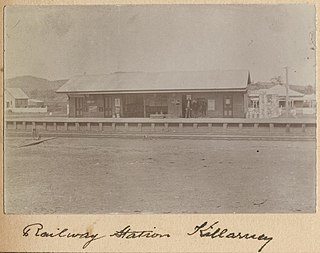
The Granite Belt is an area of the Great Dividing Range in the Darling Downs region of Queensland and the New England region of New South Wales, Australia. The Granite Belt is centred on the town of Stanthorpe. The cool, high country of the granite belt is located on Queensland's southern border. It is the northernmost part of the New England Tablelands.
The North Coast railway line is a 1,681-kilometre (1,045 mi) 3-foot 6-inch gauge railway line in Queensland, Australia. It commences at Roma Street station, Brisbane, and largely parallels the Queensland coast to Cairns in Far North Queensland. The line is electrified between Brisbane and Rockhampton. Along the way, the 1680 km railway passes through the numerous towns and cities of eastern Queensland including Nambour, Bundaberg, Gladstone, Rockhampton, Mackay and Townsville. The line though the centre of Rockhampton runs down the middle of Denison Street.

The Shire of Stanthorpe was a local government area of Queensland, Australia on the Queensland-New South Wales border. It was on the Great Dividing Range and was part of the Granite Belt. Its main industries included fruit and vegetable growing, wineries and tourism, and sheep and cattle grazing.

The Southern Downs Region is a local government area in the Darling Downs region of Queensland, Australia, along the state's boundary with New South Wales. It was created in 2008 from a merger of the Shire of Warwick and the Shire of Stanthorpe.

Brisbane, the capital city of the Australian state of Queensland, has a network of suburban railways that carry commuters, long-distance passengers, and freight. Suburban and interurban passenger services in Brisbane and South East Queensland are operated by the Queensland Rail City network, a branch of Queensland Rail, which operates long-distance trains across the state. Aurizon and Pacific National operate freight services.

The South Western line is a narrow gauge railway line in the southern part of the state of Queensland, Australia. It junctions from the Southern line immediately south of Warwick station and proceeded westwards for a distance of 413 km to the town of Dirranbandi. A western extension to Boomie in New South Wales, approved by the Queensland Parliament in 1914, was never constructed. The Thallon-to-Dirranbandi section was closed on 2 September 2010.

The Texas railway line is a disused branch railway of the South Western railway line in the south of the Darling Downs region of Queensland, Australia, and was the last traditional branch line railway constructed in Queensland.

The Killarney railway line was a branch railway in the Darling Downs region of Queensland, Australia. It travelled from Warwick to Killarney and operated from 1884 to 1964.

The Goomburra railway line was a branch railway in the Southern Downs region of Queensland, Australia.

The Southern railway line serves the Darling Downs region of Queensland, Australia. The 197-kilometre (122 mi) long line branches from the Western line at Toowoomba, 161 kilometres (100 mi) west of Brisbane, and proceeds south through Warwick and Stanthorpe to the New South Wales/Queensland state border at Wallangarra.

Queensland's railway construction commenced in 1864, with the turning of the first sod of the Main Line by Lady Diamantina Bowen, the wife of Queensland's first governor Sir George Bowen at Ipswich, Queensland, Australia. A narrow gauge of 3 ft 6 in was selected due to cost savings in providing a rail link to Toowoomba. Despite being built with bridges wide enough for standard gauge, and the fact that most other lines did not require heavy earthworks, the gauge remained the Queensland system norm.

Applethorpe is a rural town and locality in the Southern Downs Region, Queensland, Australia. In the 2016 census the locality of Applethorpe had a population of 511 people.

Amiens is a rural locality in the Southern Downs Region, Queensland, Australia. In the 2016 census Amiens had a population of 293 people.

Dalveen is a town and a locality in the Southern Downs Region, Queensland, Australia. It borders New South Wales. In the 2016 census, Dalveen had a population of 335 people.

The Main Line is a railway line in South East Queensland, Australia. It was opened in a series of sections between 1865 and 1867. It commences at Roma St Station in Brisbane and extends west 161 km to Toowoomba. It is the first narrow gauge main line constructed in the world. The section of the line from the end of Murphys Creek railway station to the Ruthven Street overbridge, Harlaxton is listed on the Queensland Heritage Register. The Murphys Creek Railway Complex, the Lockyer Creek Railway Bridge (Lockyer), the Lockyer Creek Railway Bridge and Swansons Rail Bridge are also heritage listed.

Wallangarra railway station is a heritage-listed railway station at Woodlawn Street, Wallangarra, Southern Downs Region, Queensland, Australia. It was built in 1877 along the state border of Queensland and New South Wales It was added to the Queensland Heritage Register on 28 March 2003.

Stanthorpe railway station is located on the Southern line in Queensland, Australia, serving the town of Stanthorpe.

Pikedale is a rural locality in the Southern Downs Region, Queensland, Australia. In the 2016 census Pikedale had a population of 39 people.

Pozieres is a rural locality in the Southern Downs Region, Queensland, Australia. In the 2016 census Pozieres had a population of 145 people.

Cottonvale is a locality in the Southern Downs Region, Queensland, Australia. It borders New South Wales. In the 2016 census, Cottonvale had a population of 148 people. It contains the town of Cotton Vale.
"Triumph of the Narrow Gauge: A History of Queensland Railways" by John Kerr 1990 Boolarong Press, Brisbane


















